ORNO OR-CR-243 Handleiding
ORNO
Bewegingsdetector
OR-CR-243
Bekijk gratis de handleiding van ORNO OR-CR-243 (4 pagina’s), behorend tot de categorie Bewegingsdetector. Deze gids werd als nuttig beoordeeld door 23 mensen en kreeg gemiddeld 4.7 sterren uit 12 reviews. Heb je een vraag over ORNO OR-CR-243 of wil je andere gebruikers van dit product iets vragen? Stel een vraag
Pagina 1/4

OR- -2CR 43
(PL) Czujnik ruchu
(EN) Motion sensor
(DE) Bewegungssensor
ORNO-LOGISTIC Sp. z o.o.
ul. Rolników 437
44-141 Gliwice POLAND
tel. (+48) 32 43 43 110
WAŻNE!
Przed rozpoczęciem korzystania z urządzenia, należy zapoznać się z niniejszą instrukcją obsługi oraz zachować ją na przyszłość. Dokonanie samodzielnych napraw i modyfikacji skutkuje utratą
gwarancji. Producent nie odpowiada za uszkodzenia mogące wyniknąć z nieprawidłowego montażu czy eksploatacji urządzenia.
Z uwagi na fakt, że dane techniczne podlegają ciągłym modyfi wo do dokonywania zmian dotyczących charakterystyki wyrobu oraz wprowadzania innych kacjom, Producent zastrzega sobie pra
rozwiązań konstrukcyjnych niepogarszających parametrów i walorów użytko wych produktu.
Dodatkowe informacje oraz wsparcie techniczne związane z produktem dostępne na: www.support.orno.pl. Orno-Logistic Sp. z o.o. nie ponosi odpowiedzialności za skutki wynikające z
nieprzestrzegania zaleceń niniejszej instrukcji. Firma Orno-Logistic Sp. z o.o. zastrzega sobie prawo do wprowadzania zmian w instrukcji - aktualna wersja do pobrania ze strony
www.support.orno .pl. Wszelkie prawa do tłumaczenia/interpretowania oraz prawa autorskie niniejszej instrukcji są zastrzeżone.
1. Instalacji musi dokonywać elektryk lub osoba doświadczona.
2. Wszelkie czynności wykonuj przy odłączonym zasilaniu. W tym celu odłącz bezpieczniki.
3. Nie zanurzaj urządzenia w wodzie i innych płynach.
4. Nie obsługuj urządzenia gdy uszkodzona jest obudowa.
5. Nie otwieraj urządzenia i nie dokonuj samodzielnych napraw.
6. Nie używaj urządzenia niezgodnie z jego przeznaczeniem.
IMPORTANT!
Before using the device, read this Service Manual and keep it for future use. Any repair or modification carried out by yourselves results in loss of guarantee. The manufacturer is not responsible
for any damage that can result from improper device installation or operation.
In view of the fact that the technical data are subject to continuous modifications, the manufacturer reserves a right to make changes to the product characteristics and to introduce different
constructional solutions without deterioration of the product parameters or functional quality.
Additional information and technical support related to the product is available at support.orno.pl. Orno-Logistic Sp. z o.o. holds no responsibility for the results of non-compliance with the : www.
provisions of the present Manual. Orno Logistic Sp. z o.o. reserves the right to make changes to the Manual - the latest version of the Manual can be downloaded from www.support.orno.pl. Any
translation/interpretation rights and copyright in relation to this Manual are reserved.
1. Installation must be carried out by an electrician or an experienced person.
2. Disconnect the power supply before any activities on the produ ct.
3. Do not immerse the device in water or other fluids.
4. Do not operate the device when its housing is damaged.
5. Do not open the device and do not repair it by yourselves.
6. Do not use the device against its intended use.
WICHTIG!
Bevor Sie das Gerät anschließen und benutzen, lesen Sie bitte diese Anleitung sorgfältig durch. Eigene Reparaturen und Modifikationen führen zum Verlust der Garantie. Der Hersteller haftet
nicht für Schäden, die durch unsachgemäße ienung des Gerätes ent tehen können.Montage oder Bed s
Da technische Daten ständigen Modifikationen unterliegen, behält sich der Hersteller das Recht vor, Änderungen bezüglich Erzeugnischarakteristik und anderer Konstruktionsänderungen
vorzunehmen, die Parameter und Nutzwerte des Produkts nicht b eeinträchtigen.
Weitere Informationen und technische Unterstützung zu diesem Produk Logistic Sp. z o.o. haftet nicht für die Folgen der Nichtbeachtung der t finden Sie unter: www.support.orno.pl. Orno-
Anweisungen in dieser Bedienungsanleitung. Orno-Logisti ehmen - aktuelle Version zum Herunterladen unter c Sp. z o.o. behält sich das Recht vor, Änderungen in der Bedienungsanleitung vorzun
www.support. ser Bedienungsanleitung sind vorbehalten. orno.pl. Alle Rechte an Übersetzung/Dolmetschen und Urheberrechten an die
1. Die Montage darf Elektriker oder eine erfahrene Person durchführen.
2. Alle Arbeiten führen Sie bei ausgeschalteter Stromversorgung aus. Schalten Sie die Sicherungspatronen aus.
3. Tauchen Sie das Gerät nicht in das Wasser oder die anderen Flüssigkeiten.
4. Nutzen Sie das Gerät nicht, wenn sein Gehäuse beschädigt ist.
5. Öffnen Sie das Gerät nicht und nehmen Sie selbständig keine Reparaturen vor.
6. Nutzen Sie das Gerät seinem Zweck entsprechend.
Każde gospodarstwo jest użytkownikiem sprzętu elekt ronicznego, a co za tym idzie potencjalnym wytwórcą niebezpiecznego dla ludzi i środowiska odpadu, z tytułu rycznego i elekt
obecności w sprzęcie niebezpiecznych substancji, mieszanin oraz części składowych. Z drugiej strony zużyty sprzęt to cenny materiał, którego możemy odzyskać sur z owce takie jak
miedź, cyna, szkło, żelazo i inne.
Symbol przekreślonego kosza na śmieci umieszczany na sprzęcie, opakowaniu lub dokumentach do niego dołączonych oznacza, że produktu nie wolno wyrzucać łącznie z innymi
odpadami Oznakowanie oz . nacza jednocześnie, że sprzęt został wprowadzony do obrotu po dniu
13 sierpnia 2005 r. Obowiązkiem użytkownika jest przekazanie zużytego sprzętu do wyznaczonego punktu zbiórki w celu właściweg macje o dostępnym o jego przetworzenia. Infor
systemie zbierania zużytego sprzętu elektrycznego można znaleźć w punkcie informacyjnym sklepu oraz w urzędzie miasta/gminy. Odpowiednie postępowanie ze zużytym sprzętem
zapobiega negatywnym konsekwencjom dla środowiska naturalnego i ludzkiego zdrowia!
Eac household is a user of electrical and electronic equipment, and hence a potential producer of hazardous waste for humans and the environment, due to the presence of hazardoush
substances, mixtures and components in the equipment. On the other hand, used e ipment is valuable material from which we can recover raw materials such as copper, tin, glass,qu
iron and others. The weee sign placed on the equipment, packaging or documents attached to it indicates the need for selective collection of waste electrical d electronic equipmentan
Products so marked, under penalty of fine, cannot be thrown into ordinary garbage along with other waste. The marking means at the same time that the equipment was placed on the
market after August 13, 2005. It is the responsibili of the user to hand the used equipment to a designated collection point for proper processing. Used equipment can also be handedty
over to the seller, if one buys a new product in an amount not greater than the new purchased equipment of the same type. In rmation on the available collection system of wastefo
electrical equipment can be found in the information desk of the store and in the municipal office or district office. Proper handling of used equipment prevents negative consequences
for the environmen and human health!t
Jeder Haushalt ist ein Anwender von Elektro- vonund Elektronikgeräten und damit ein potenzieller Erzeuger von Abfällen, die für Mensch und Umwelt aufgrund des Vorhandenseins
gefährlichen Stoffen, Gemischen und Komponenten in den Gerä n gefährlich sind. Andererseits sind Altgeräte ein wertvoller Rohstoff, aus dem Rohstoffe wie Kupfer, Zinn, Glas, Eisente
und andere zurückgewonnen werden können. Das Symbol der durchgestrichenen Mülltonne auf der Verpackung, dem Gerät oder den dazugehörigen Dokumenten, weist auf die
Notwendigkeit der getrennten Sammlung von Elektro- und Elektronikaltgeräten hin. Auf diese Weise gekennzeichnete Produkte dürfen unter Strafe nicht zusammen mit anderen
Abfällen entsorgt werden. Die Kennzeic dass die Geräte nach dem 13 August 2005 in Verkehr gebracht wurden. Es liegt in der Verantwortung deshnung weist gleichze ig darauf hin, it
Benutzers, die Altgeräte zur ordnungsgemäßen Behandlung an eine dafür vorgesehene Sammelstelle zu bringen. Informationen über das verfügbare System zur Sammlung von
Elektroaltgeräten finden Sie in der Informationsstelle des Ladens und im Magistrat/Gemeindeamt. Ein sachgemäßer Umgang mit Altgeräten verhindert negative Folgen für die Umwelt
und die menschliche Gesundheit!
01/2021

2
SKRÓCONA INSTRUKCJA OBSŁUGI/ QUICK GUIDE/ KURZANLEITUNG
L - ’Napięcie wyjściowe/ Output
voltage/Ausgangsspannung
(czerwony/red/Rot)
N - Zacisk neutralny/ Neutral
terminal/ Neutrale Klemme
(niebieski/blue/Blau)
L - Napięcie wejściowe/ Input
voltage/ Eingangsspannung
( brown/Braun)brązowy/
- Obciążenie/load/Belastung
rys.1/ fig.1/ Abb .1
rys.2/ fig.2/ Abb.2
rys.3/ fig.3/ Abb.3
rys.4/ fig. 4/ Abb. 4
rys.5/ fig. 5/ Abb. 5
rys.6/ fig.6/ Abb.6
SPECYFIKACJA TECHNICZNA/ TECHNICAL DATA/ TECHNISCHE DATEN
Zasilanie
Power supply
Stromversorgung
230V~, 50Hz
Max. obciążenie
Max. load
Max. Belastung
800 200W W
Pobór prądu
Power consumption
Stromaufnahme
0,5W
Kąt detekcji czujnika
Detection angle
Erfassungswinkel
360°
Regulacja czujnika natęże światłania
Adjustable daylight sensor
Einstellbarer Tageslichtsensor
<3-2000 lux
Regulacja czasu świecenia
Adjustable time setting
Einstellbare Leuchtdauer
min. 10sek.±3sek.
m 15 2min. ax. min.±
Zasięg detekcji czujnika
Detection range
Erfassungsbereich
max 6 . m
Stopień ochrony
Protection level
Schutzart
IP20
Waga netto
Net weight
Nettogewicht
0,1 06kg
Temp. pracy
Working temperature
Betriebstemperatur
-20 0C-400C
Wysokość montażu
Installation height
Montagehöhe
2 - ,2 4m
Współpracuje z L ED
Works with LED
Arbeitet mit LED
✓
Czujnik obecności
Presence sensor
Anwesenheitssensor
Przekaźnik
Relay
Relais
✓
PL
Instrukcja obsługi
CHARAKTERYSTYKA
Czujnik jest przystosowany do montażu w sufitach podwieszanych. Służy do automatycznego sterowania oświetleniem (włączania i wyłączania) lub innymi urządzeniami elektrycznymi przy
jednoczesnej oszczędności energii elektrycznej. Oświetlenie jest włączane za pomocą czujnika ruchu PIR, który działa na podczerwień. Czujnik posiada regulację cza działania (TIME) oraz natężesu nia
światła (LUX).
OGÓLNE INFORMACJE
Przed wybraniem miejsca montażu czujnika należy wziąć pod uwagę poniższe uwagi:
- - 4 m; wysokość montażu 2,2
- ki, klimatyzatory; unikać montowania w sąsiedztwie urządzeń wytwarzających ciepło np. grzejni
- nie zaleca ; się instalowania czujnika naprzeciwko powierzchni silnie odbijających światło takich jak np. lustra itp.
- nie montować w zasięgu jasnego źródła światła;
- e pole elektromagnetyczne. czujnik nie powinien znajdować się blisko urządzeń emitujących siln
- unikać kierowania czujnika w kierunku obiektów, które mogą być poruszane np. wiatrem, jak zasłony, wysokie rośliny itp.
INSTALACJA
1. Rozłącz obwód zasilania.
2. . Unieś plastikową pokrywę czujnika i wyreguluj pokrętła „TIME” i „LUX”
3. isk Poluzuj śruby w kostce zac owej, a następnie podłącz zasilanie i wszystkie przewody elektryczne zgodnie ze schematem podłączenia przewodów.
4. Odegnij metalową sprężynę czujnika do góry, aż znajdzie się w położeniu „I” z czujnikiem, następnie włóż czujnik do otworu w suficie lub d puszki instalacyjnej o takim samym rozmiarze jak o
czujnik. Po zwolnieniu sprężyny, czujnik zostanie zamontowany,
5. Po zakończeniu instalacji, włącz zasilanie i przetestuj czujnik.
TEST
Czujnik wyposażony jest w dwa pokrętła:
TIME - su umożliwia określenie cza przez jaki urządzenie będzie działało po aktywacji czujnika, czas świecenia czujnika jest regulowany:

3
min czas świecenia to 10 sek.±3 sek.; max czas świecenia to 15 min ±2 min.
LUX - wietleni ik lenia umożliwia ustawienie poziomu natężenia oś a, przy którym czujn będzie mógł uaktywnić urządzenie do niego podłączone, zabezpiecza to przed niepożądanym włączaniem oświet
podczas dnia, poziom natężenia światła przy jakim czujnik zaczyna wykrywać ruch jest regulowany od 3 do 2000 lux.
1. Ustaw pokrętło “TIME” w pozy kazówek zegara (10S) a pokrętło “LUX” w kierunku zgodnym z ruchem wskazówek zegarcji przeciwnej do ruchu ws a na maximum .
2. Włącz zasilanie. Czujnik i połączone do niego oświetlenie na początku nie odnajdą sygnału.
3. Po ok. 30 sekundach czujnik powinien roz począć pracę. Jeśli czujnik wychwyci sygnał, oświetlenie się włączy. Jeśli sygnał ustanie, odbiornik powinien przestać pracować w ciągu 10s ± 3s a
oświetlenie wyłączyć się.
4. erunku przeciwnym do ruchu m ( Przekręć pokrętło LUX w ki wskazówek zegara, na minimu 3). Jeśli natężenie światła otoczenia jest większe niż 3 LUX, czujnik przestanie działać i oświetlenie
również. Jeśli natężenie światła otoczenia jest mniejsze niż 3 LUX (ciemność), czujni racować. k zacznie p
5. W przypadku bra ku sygnału, czujnik powinien przestać pracować w ciągu 10 s ± 3 s.
UWAGA: Podczas przeprowadzania testu czujnika w dzień pokrętło LUX należy ustawić na w przeciwnym razie czujnik nie będzie działał prawidłowo. pozycje MAX
NIEKTÓRE PROBLEMY I SPOSOBY ICH ROZWIĄZANIA
1. Światło nie dział a:
a. Sprawd ż poprawność podłączenia zasilania i odbiornika.
b. Sprawdź obciążenie.
c. Sprawdź poziom natężenia oświetlenia otoczenia
2. Słaba czułość:
a. Sprawd , czy przed czujnikiem ż nie znajdują się urządzenia, które mogą zakłócić od ne sygnałybiera .
b. Sprawdź czy temperatura otoczenia nie jest za wysoka.
c. Sprawdź, czy wykrywany obiekt znajduje się w polu detekcji
d. Sprawdź wysokość instalacji.
e. Sprawdź czy kierunek orientacji czujnika jest poprawny.
3. Czujnik nie może automaty ie wyłączyć obciążenia:czn
a. Sprawdź, czy w polu detekcji występują ciągłe sygnały ruchu.
b. Sprawdź czy opóźnienie czasowego nie jest ustawione na najdłuższą wartość.
c. Sprawdź czy zasilanie jest zgodne z instrukcją.
BEZPIEC I KONSERWACJAZEŃSTWO
Konserwa cji dokonywać przy odłączonym zasilaniu.
Czyścić wyłącznie delikatnymi i suchymi tkaninami.
Nie używać chemicznych środków czyszczących.
Nie zakrywać urządzenia.
Montować z dala od źródeł ciepła.
EN
Operating and installati instructions on
DESCRIPTION
The sensor is suitable for installation in suspended ceilings. The sensor is used to automatically control lighting (switching on and off) or other electrical devices, that helps to save electricity. The
receiver (lighting) is switched on by means of the PIR motion sensor that is the passive infrared sensor. The sensor has adjustable operating time (TIME) and light intensity (LUX).
GENERAL REMARKS
While choosing a place of installation, consider the following criteria:
- height of installation: 2.2-4 m;
- do not install the device nearby heaters, fans and other objects where the temperature can change rapidly,
- it is not recommended to install the sensor opposite to highly reflective surfaces such as mirrors etc;
- do not install within the range of a bright light source;
- do not install in the vicinity of strong sources of electromagnetic interference,
- avoid directing the sensor towards objects that can be moved by the wind, such as curtains, tall plants, etc.
INSTALLATION
1. Disconnect power source.
2. Lift the plastic cover of the sensor and adjust the "TIME" and "LUX" knobs.
3. Loosen the screws in the terminal block and then connect the power supply and all electrical wires according to the wiring diagram.
4. Bend the sensor's metal spring upwards until it is in position "I" with the sensor, then insert the sensor into a hole in the ceiling or into an installation box of the same size as the sensor. When the
spring is released, the sensor will be installed.
5. After installation, turn on the power and test the sensor.
TEST
The sensor is equipped with two knobs:
TIME allows to specify the time of the device operation after the sensor activation, the sensor's light time is adjustable: –
min lighting time is 10 sec ±3 sec; ighting time is 15 min ±2 min.max l
LUX - allows you to set the level of light intensity at which the sensor will be able to activate the device connected to it, this protects against unwanted switching of lighting during the day, the level
of light intensity at which the sensor starts to detect movement is adjustable from 3 to 2000 lux.
1. Turn the "TIME" knob counterclockwise (10sec) and the "LUX" knob clockwise to maximum .
2. Turn on the power. The sensor and the lighting connected to it will not find a signal at first.
3. After approx. 30 seconds the sensor should start working. If the sensor detects a signal, the lighting switches on. If the signal stops, the receiver should stop working w ithin 10s ± 3s and the
lighting switches off.
4. Turn the LUX knob counterclockwise to minimum (3). If the ambient light intensity is exceeded 3 LUX, the sensor will stop working and the lighting will also stop. If the ambient light intensity is
less than 3 LUX (darkness), the sensor will start operating.
5. If there is no signal, the sensor should stop working with in 10 s ± 3 s.
Note: when testing in daylight, please turn LUX knob to (MAX ) position, otherwise the sensor could not work properly!
SOME PROBLEMS AND SOLUTIONS
1. The load does not work:
a Please check if the connection of power source and load is correct. .
b Please check if the load is good. .
c Please check if the settings of working light correspond to ambient light. .
2. The sensitivity is poor:
a Please check if there is any hindrance in front of the detector to affect it to receive the signals . .
b Please check if the ambient temperature is correct. .
c Please check if the induction signal source is in the detection field. .
d. Please check if the installation height corresponds to the height required in the instruction.
e. Please check that the orientation of the sensor is correct.
3. The sensor cannot shut off the load automatic ally:
a Please check if there is continual signal in the detection field. .
b Please check if the time delay is set to the maximum position. .
c Please check if the power corresponds to the instruction..
Product specificaties
| Merk: | ORNO |
| Categorie: | Bewegingsdetector |
| Model: | OR-CR-243 |
Heb je hulp nodig?
Als je hulp nodig hebt met ORNO OR-CR-243 stel dan hieronder een vraag en andere gebruikers zullen je antwoorden
Handleiding Bewegingsdetector ORNO
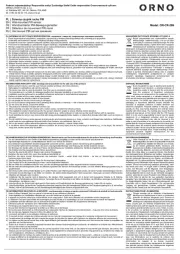
11 Augustus 2025
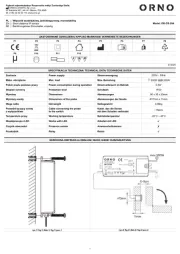
11 Augustus 2025
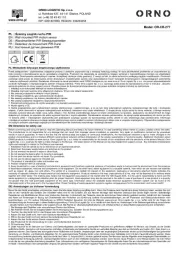
11 Juni 2025
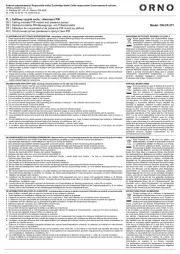
11 Juni 2025
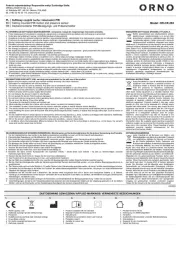
10 Juni 2025

10 Juni 2025
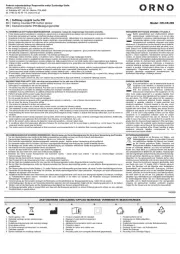
10 Juni 2025
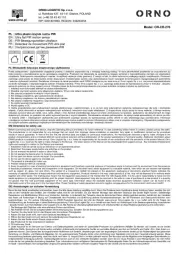
10 Juni 2025
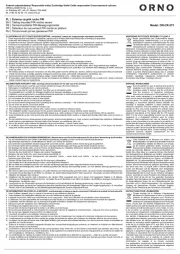
10 Juni 2025

9 September 2024
Handleiding Bewegingsdetector
- Pentatech
- D-Link
- Crestron
- Konig
- Marmitek
- ESYLUX
- Gewiss
- Theben
- Satel
- Eminent
- KlikaanKlikuit
- Vernier
- Alecto
- TP Link
- Vemer
Nieuwste handleidingen voor Bewegingsdetector
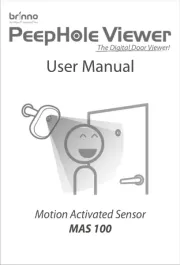
9 September 2025
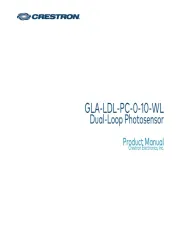
8 September 2025
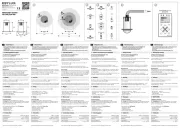
6 Juli 2025
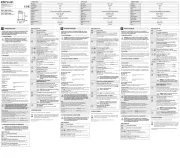
6 Juli 2025
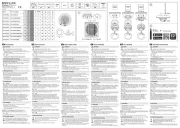
5 Juli 2025

5 Juli 2025
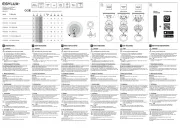
5 Juli 2025
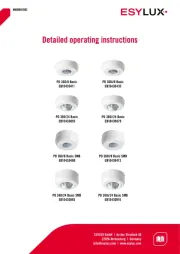
5 Juli 2025
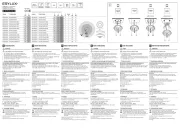
5 Juli 2025
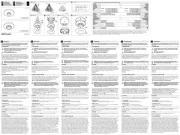
5 Juli 2025